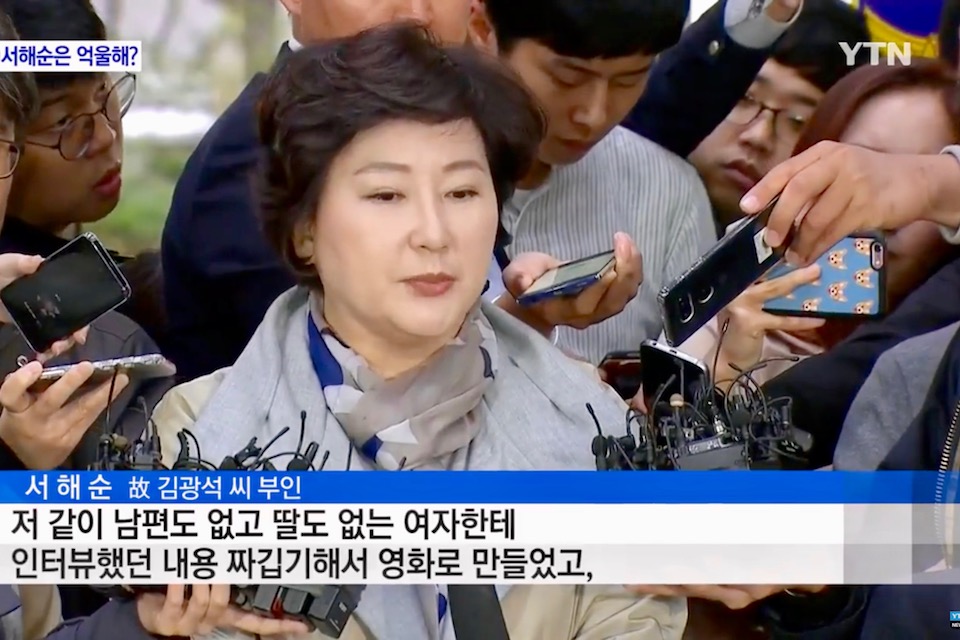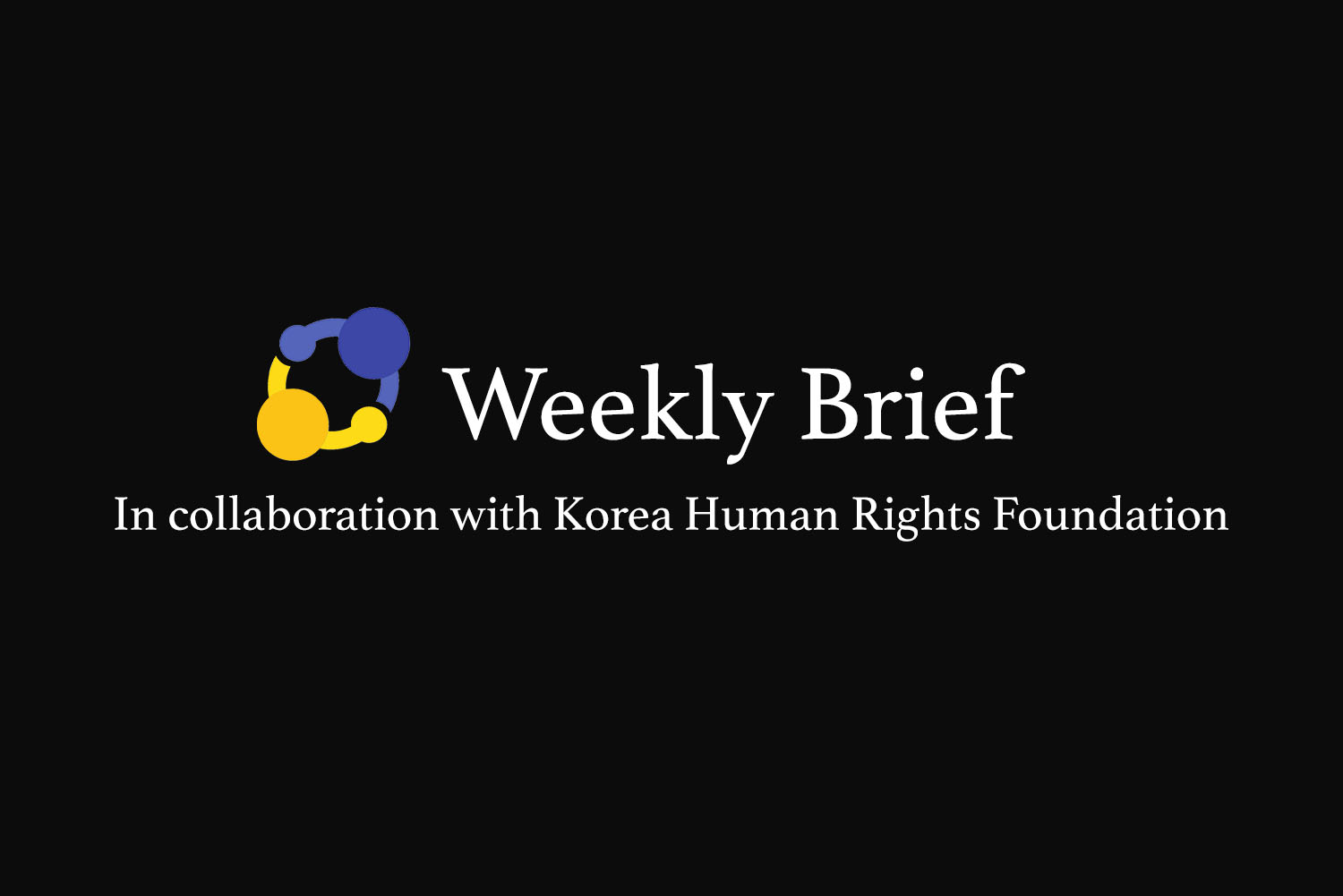
Is She a Murderess or a Victim?
At the funeral, the deceased’s wife stood calmly. She didn’t cry or make any other overt show of emotion. Her demeanor contrasted sharply with her late husband’s parents and siblings, who cried and wailed, doubled over with grief.
The difference in these reactions was highlighted by Lee Sang-ho, director of Suicide Made, a documentary released in theaters in late August. The film tells the story of Kim Kwang-seok, a legendary South Korean folk rock singer-songwriter. In the 1980s and 90s, Kim built a passionate fanbase with his poignant songs, on the strength of his sentimental lyrics and guitar playing.
The release of Lee’s film 20 years after Kim’s death has reignited interest in the case. Kim died abruptly in 1996 at the age of 32. Investigators concluded that he had committed suicide by hanging himself. The official story is that, after drinking with his wife at night, Kim hung himself with an electrical cord on the stairs of their apartment building.
But soon after his death another theory began to circulate: that Kim’s wife, Seoh Hai-soon, the only witness of his death, had murdered him. Seoh’s motive, Lee suggests, was inheriting Kim’s money. After her husband’s death, she allegedly came into a large fortune worth more than 10 billion won (roughly $9 million), including a building in Seoul and the copyrights to Kim’s music.
The film and its reception revealed a dark side of South Korean society, where online witch hunts are pervasive. This time, unsubstantiated allegations against Seoh have made her the target of a smear campaign: She may have become one of the most hated women in South Korea.
Wild accusations
In the film, which was first shown at a film festival last year, Lee makes the case that Seoh is her husband’s killer. Much of this claim is based on what he describes as conflicting and nonsensical accounts Seoh gave of that night’s events — to her mother and investigators. She flip-flopped during the investigation: At first, she claimed that she had discovered her inert husband when she ran out of her room upon hearing a thump. But later she said she was bringing a quilt for her husband, only to find him unconscious.
One inconsistency that Lee’s film hones on in concerns the ashtray found in Kim’s apartment.
Even though there were more than 30 cigarette butts of two types in the ashtray, Seoh said that only she and Kim had been drinking that night. But Seoh was not a smoker, at least in front of her husband, according to an anonymous friend interviewed in the film. In recent interviews of her own, Seoh claimed not to know about the cigarettes. The discrepancy in that account spawned suspicions in Lee: He suspects that Seoh may be hiding someone’s presence that night to cover up her guilt or that of an accomplice.
According to Seoh herself, her brother, an ex-convict, was staying on the first floor of the same building that night. But she claims not to have known his presence until she went down to fetch the paramedics, whereupon he ran up to the flat with them.
The film introduces an array of such circumstantial evidence, but not what could be the most convincing piece of evidence to prove Seoh’s culpability: the autopsy report.
Lee says he couldn’t acquire the autopsy report because Seoh withheld access from everyone else, even Kim’s family. And without the autopsy report, Lee can’t make a conclusive case that Kim was murdered.
After the film sparked nationwide fascination, broadcaster SBS actually succeeded in obtaining the autopsy report. When asked, Lee said he didn’t know how they obtained it. (Reached by Korea Exposé, SBS journalist Jeon Hyeong-woo declined to disclose his source.)
The autopsy report indicates that Kim died of suicide by hanging and provides no evidence that he was strangled, seeing as his body had no marks of a physical struggle. His blood alcohol level was 0.09 percent, meaning he would have been tipsy. No drugs or other toxins were found in his body.
But a new detail was found in the report: Kim bore scars from old cuts on his wrists, which may have been incurred in a previous suicide attempt.
Witch hunt
Without any hard evidence to overturn investigators’ official conclusion, experts are circumspect about revisiting the case. But Seoh is guilty in the minds of many South Koreans, partially due to the underlying mistrust of governmental authority, which snowballed in recent years as the government politicized matters such as the Sewol ferry sinking.
After the film’s release, allegations concerning Seoh mushroomed, especially as Lee continued his campaign against her. Lee depicted Seoh as a cheating wife who had killed her husband and a horrible mother who caused the death of their only, disabled daughter. He also made her out to be a habitual liar who hid an extramarital relationship with Kim’s friend and concealed the death of her daughter to win a lawsuit against her in-laws over the inheritance.
In South Korea, online vigilantes carry out witch hunts against plenty of ordinary people. With their own idea of justice, they ruthlessly unearth personal details about the targets, infringing on their privacy and safety. But in Seoh’s case, the press helmed the probe, often disregarding journalistic ethics.
Lee claimed assertively in the movie, without showing any evidence, that Seoh had murdered her newborn baby from a previous marriage before meeting Kim. One station, TV Chosun, then filmed a man inside Seoh’s house, using a long-range lens, and suggested that this man was her romantic partner and Kim’s old friend. Other outlets examined her addresses and real estate documents to castigate her luxurious lifestyle.
Dispatch, a tabloid news website known for sparking scandals involving high-profile celebrities, investigated Seoh’s whereabouts in Hawaii after her daughter’s death in 2007. It acquired business registration documents and an annual financial statement from the liquor store that Seoh allegedly ran with her partner (whose name matches that of the individual with whom Seoh allegedly had affairs). Journalists from various media outlets spoke to Seoh’s neighbors and regurgitated their stories about her without attempting to verify any detail.
Seoh is not the only one to whom this type of thing has happened. Kyungpook National University Professor Kim Gho told Korea Exposé that while online witch hunts aren’t unique to South Korea, “because of strong collectivism and the limited number of online communities where opinions assemble, its scope of dissemination tends to be wider.”
A similar case involved Hong Ga-hye, who was lambasted after criticizing the Korea Coast Guard’s feeble effort in rescuing the Sewol ferry. Then, she was only a passionate 26-year-old who rushed to Paengmok Port upon hearing about the sinking. As an amateur diver, Hong tried to assist the rescue process, only to be told to leave.
Frustrated, she told her story to one cable news channel, prompting criticism of the government. But once the Coast Guard denied her claims and authorities arrested her on the charge of defamation, the public turned against Hong. Then, the media instigated a witch hunt by unearthing false details of Hong’s past and painting her as a pathological liar.
It took over three years for the tabloid newspaper Sports Seoul, which swayed public opinion by spreading malicious and false rumors about Hong, to publicly apologize. By then, the damage was done.
Convincing the masses
As a celebrated investigative journalist, Lee runs a supporter-funded outlet called Gobal News. (Gobal means to level accusations or file criminal complaints.) Lee has often fought battles against powerful institutions, be they the government or conglomerates. Throughout his solitary yet daring journey, it has usually been public support that enabled his reporting. Lee’s first documentary, Diving Bell, for instance, accused the government of a lackluster rescue effort during the Sewol ferry sinking.
Government officials and right-wing politicians hindered the film’s screening, but Diving Bell wasn’t buried. People talked about it. Though only screened at a handful of theaters, it ranked first on various movie sites following its online release.
Believing that the truth about Kim’s death had not come out, Lee chose to use the same tactic: making a movie about the case.
Reached by phone, Lee told Korea Exposé that, with his film, he wasn’t just looking to tell a story, but to push for a legal reexamination of the case. “Because it’s been such a long time since the incident, I intended to raise suspicions before an audience and solicit the help of investigating agencies so that the case would be reopened.”
Part of Lee’s efforts in publicizing the case against Seoh has yielded results. The death of Kim Seo-yeon, the only child between Kim and Seoh, is under reinvestigation after almost 10 years. Lee claims Seoh had neglected her ill daughter till death. Seoh is barred from leaving the country until the investigation ends.
Lee has also pleaded that Kim’s case be reopened even though the statute of limitation has expired. The statute of limitation for murder was eliminated in 2015, but not retroactively applied to cases already closed. Hence, Kim’s death is excluded.
Lee has collected over 50,000 signatures to push for the passing of a law named after Kim, which would enable the reopening of murder cases whose statute of limitation has already expired, once compelling evidence appears.
Lee is among journalists that conduct their own extrajudicial investigations, based on their suspicions regarding criminal cases. But appealing to the general public in a bid to influence a case risks undermining the integrity of the judicial process.
Seoh’s innocence should be presumed unless she is found guilty in a court of law. But Lee and South Korean media seem to have succeeded in convicting her in the court of public opinion.
Cover image: Seoh Hai-soon gave a statement to the press denouncing Lee Sang-ho’s movie Suicide Made as spreading malicious falsehood about her. (Source: YTN)

